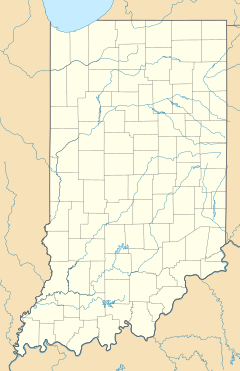Strawtown, Indiana facts for kids
Quick facts for kids
Strawtown, Indiana
|
|
|---|---|
| Country | United States |
| State | Indiana |
| County | Hamilton |
| Township | White River |
| Elevation | 794 ft (242 m) |
| ZIP code |
46060
|
| FIPS code | 18-73682 |
| GNIS feature ID | 444266 |
Strawtown is a small, unincorporated community located in White River Township, Hamilton County, Indiana. An "unincorporated community" means it's a group of homes and businesses that isn't officially a city or town with its own local government.
Contents
History of Strawtown
Strawtown was once a village for Native American tribes. White settlers started to develop the area in 1819. They wanted to create a place for travelers to stop and rest.
Early Settlements and Trails
Strawtown was located on the Conner Trail. This trail connected the cities of Cincinnati and Indianapolis. Strawtown was a convenient halfway point between Anderson and Indianapolis. In 1836, Bicknell Cole and William Conner officially planned out the town. This process is called "platting."
Native American Heritage
The area might have been named after a Native American Delaware chief. His name was possibly Straw or Strawbridge. The original Native American village of Strawtown was about 1.5 miles (2.4 km) east and north of where Strawtown is today. The Miami and Shawnee tribes invited the Delaware people to live in the White River basin after a treaty in 1795. Indian Strawtown was one of 14 Delaware villages built along the West Fork of the river.
Land Sales and Growth
In 1821, people could buy land in Strawtown. The minimum purchase was 80 acres (32 hectares) for $1.25 per acre. The next year, five settlers from Strawtown bought land at this price. By 1836, about 30 families had bought land in the area.
Community Services
A post office opened in Strawtown in 1834. It helped people send and receive mail. This post office closed in 1902. It was first set up in Stevensburg in 1829, making it one of the earliest post offices in the area.
William Foster built a saw mill two miles (3 km) downstream in what is now Clare. A saw mill cuts logs into lumber. This lumber was then tied together like a raft and floated down the river to Noblesville and Indianapolis.
Education and Development
The first school in Strawtown was organized and taught by Doctor Amos Palmer. This happened during the winter of 1822-1823. In 1823, the county was divided into two townships: White River to the north and Delaware to the south.
The state had plans to build the Central Canal through Strawtown. This idea helped the area grow quickly. However, the canal was never built in that area. This caused growth to slow down. Also, the nearest railway was four miles (6.4 km) to the west, which made it harder for Strawtown to connect with other places.
Archaeology in Strawtown
Strawtown is an important place for archaeology. Archaeology is the study of human history and prehistory through digging up old sites and artifacts.
Current Digs and Discoveries
There is an ongoing archaeological dig in Strawtown. It is funded by the National Science Foundation through Indiana University – Purdue University Fort Wayne (IPFW). The IPFW Archaeological Survey received a $10,000 grant for a two-week educational program. This program takes place at the Strawtown Koteewi Park near Noblesville.
Park and Education
This project will also help get a site near the Strawtown enclosure added to the National Register. This register lists places important to history. For the past six years, IPFW has worked with the Hamilton County Parks Department. They are exploring the unique archaeological history of the 750-acre (300-hectare) park.
Goals of the Project
The main goals of this archaeology project are:
- To learn more about the people who lived in central Indiana a long time ago.
- To create a cultural and educational resource at the park for people in central Indiana.
- To make the park's archaeological sites a popular place for tourists to visit.
Geography of Strawtown
Strawtown is located east of Cicero and northeast of Noblesville. You can find it where State Road 37 and Strawtown Avenue meet. The White River forms its northern and western borders.



